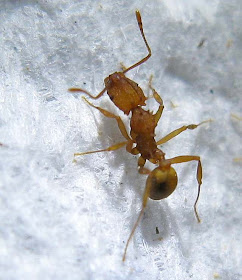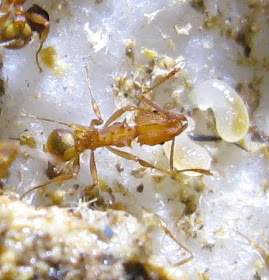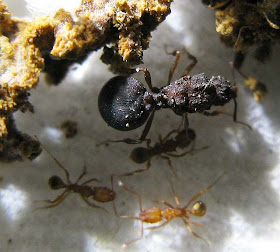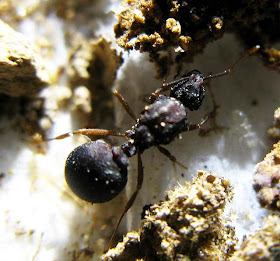This small ant tagged as Proatta butteli looks very similar to a fungus growing species of South American ant Mycocepurus. This is a polygynous monomorphic species. Proatta butteli are somewhat slow moving and not very aggressive. The queen plays dead curled up like a pupa when threatened, as also the workers froze when their nests are exposed. These are probably effective defensive strategies against large predators like birds which are visual hunters zoning in on their prey's movements.
Nest of Proatta butteli under a fallen tree branch.
Protta butteli commonly nest under fallen tree trunks and branches. They also common carpet their nests with shredded wood which might be indicative of how Atta and other fungus cultivation ants learned (
or if you prefer the correct scientific terminology – mutated) to become mushroom growing ants.
In this nest the carpet of wood shred, grass and leaves has taken on the form of a platform.
Proatta butteli workers, male (drone) and brood.
Lateral view of the male of Proatta butteli.
Frontal view of the male of Proatta butteli.
Workers of Proatta butteli.
Workers of Proatta butteli.

A worker of Proatta butteli with some larvae.
A worker of Proatta butteli
Workers of the ant species Proatta butteli.
Some workers eating a morsel of chicken.
The queen or gyne of Proatta butteli
The gyne looks likes a miniture version of that of a leaf cutter ant.
Taxonomy
Kingdom - Animalia
Phylum - Arthropoda
Subphylum - Hexapoda
Class - Insecta
Subclass - Pterygota
Infraclass - Neoptera
Order - Hymenoptera
Suborder - Apocrita
Infraorder - Aculeata
Superfamily - Vespoide
Family - Formicidae -- ants, fourmis
Subfamily - Myrmicinae
Genus: Proatta
Species: butteli
Last Updated: 2016 09 06
First Posted: 2009 10 23
© 2009 – 2016 Quah. All rights reserved.



















Where do you find this particular species around. where do they nest and if you can what time of the year do you think they fly? :P
ReplyDeletethanks
Strange never saw this comment and it is not listed in the published comments page. A little late but still relevant.
DeleteProatta butteli is a common species found in most sufficiently wooded areas. They are slow moving and freeze when the nest is exposed.